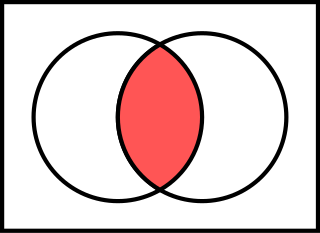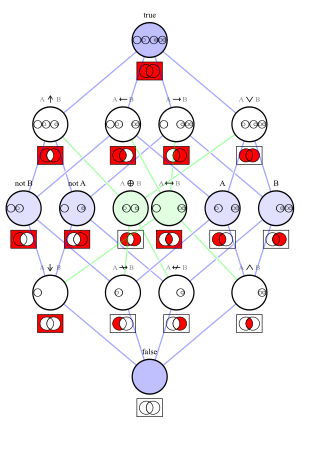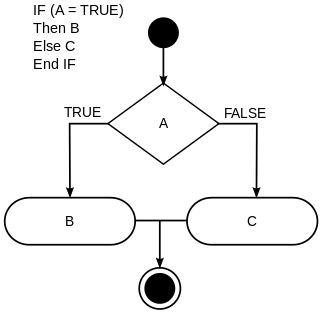Related Research Articles

In logic, disjunction, also known as logical disjunction or logical or or logical addition or inclusive disjunction, is a logical connective typically notated as and read aloud as "or". For instance, the English language sentence "it is sunny or it is warm" can be represented in logic using the disjunctive formula , assuming that abbreviates "it is sunny" and abbreviates "it is warm".

In logic, mathematics and linguistics, and is the truth-functional operator of conjunction or logical conjunction. The logical connective of this operator is typically represented as or or (prefix) or or in which is the most modern and widely used.

In logic, a logical connective is a logical constant. Connectives can be used to connect logical formulas. For instance in the syntax of propositional logic, the binary connective can be used to join the two atomic formulas and , rendering the complex formula .

In computer science and computer programming, a data type is a collection or grouping of data values, usually specified by a set of possible values, a set of allowed operations on these values, and/or a representation of these values as machine types. A data type specification in a program constrains the possible values that an expression, such as a variable or a function call, might take. On literal data, it tells the compiler or interpreter how the programmer intends to use the data. Most programming languages support basic data types of integer numbers, floating-point numbers, characters and Booleans.

In logic, negation, also called the logical not or logical complement, is an operation that takes a proposition to another proposition "not ", standing for " is not true", written , or . It is interpreted intuitively as being true when is false, and false when is true. Negation is thus a unary logical connective. It may be applied as an operation on notions, propositions, truth values, or semantic values more generally. In classical logic, negation is normally identified with the truth function that takes truth to falsity. In intuitionistic logic, according to the Brouwer–Heyting–Kolmogorov interpretation, the negation of a proposition is the proposition whose proofs are the refutations of .
Any kind of logic, function, expression, or theory based on the work of George Boole is considered Boolean.
Curry is a declarative programming language, an implementation of the functional logic programming paradigm, and based on the Haskell language. It merges elements of functional and logic programming, including constraint programming integration.

In computer science, conditionals are programming language commands for handling decisions. Specifically, conditionals perform different computations or actions depending on whether a programmer-defined Boolean condition evaluates to true or false. In terms of control flow, the decision is always achieved by selectively altering the control flow based on some condition . Although dynamic dispatch is not usually classified as a conditional construct, it is another way to select between alternatives at runtime. Conditional statements are the checkpoints in the programme that determines behaviour according to situation.
This is a list of operators in the C and C++ programming languages. All the operators listed exist in C++; the column "Included in C", states whether an operator is also present in C. Note that C does not support operator overloading.
In logic, a truth function is a function that accepts truth values as input and produces a unique truth value as output. In other words: the input and output of a truth function are all truth values; a truth function will always output exactly one truth value, and inputting the same truth value(s) will always output the same truth value. The typical example is in propositional logic, wherein a compound statement is constructed using individual statements connected by logical connectives; if the truth value of the compound statement is entirely determined by the truth value(s) of the constituent statement(s), the compound statement is called a truth function, and any logical connectives used are said to be truth functional.
In computer programming, the ternary conditional operator is a ternary operator that is part of the syntax for basic conditional expressions in several programming languages. It is commonly referred to as the conditional operator, ternary if, or inline if. An expression a ? b : c evaluates to b if the value of a is true, and otherwise to c. One can read it aloud as "if a then b otherwise c". The form a ? b : c is by far and large the most common, but alternative syntaxes do exist; for example, Raku uses the syntax a ?? b !! c to avoid confusion with the infix operators ? and !, whereas in Visual Basic .NET, it instead takes the form If(a, b, c).
Short-circuit evaluation, minimal evaluation, or McCarthy evaluation is the semantics of some Boolean operators in some programming languages in which the second argument is executed or evaluated only if the first argument does not suffice to determine the value of the expression: when the first argument of the AND function evaluates to false, the overall value must be false; and when the first argument of the OR function evaluates to true, the overall value must be true.
In computer programming, operators are constructs defined within programming languages which behave generally like functions, but which differ syntactically or semantically.
In computer science, an expression is a syntactic entity in a programming language that may be evaluated to determine its value or fail to terminate, in which case the expression is undefined. It is a combination of one or more constants, variables, functions, and operators that the programming language interprets and computes to produce another value. This process, for mathematical expressions, is called evaluation. In simple settings, the resulting value is usually one of various primitive types, such as string, boolean, or numerical.
In computer science, the Boolean is a data type that has one of two possible values which is intended to represent the two truth values of logic and Boolean algebra. It is named after George Boole, who first defined an algebraic system of logic in the mid 19th century. The Boolean data type is primarily associated with conditional statements, which allow different actions by changing control flow depending on whether a programmer-specified Boolean condition evaluates to true or false. It is a special case of a more general logical data type—logic does not always need to be Boolean.
In computer science, a relational operator is a programming language construct or operator that tests or defines some kind of relation between two entities. These include numerical equality and inequalities.
The computer programming languages C and Pascal have similar times of origin, influences, and purposes. Both were used to design their own compilers early in their lifetimes. The original Pascal definition appeared in 1969 and a first compiler in 1970. The first version of C appeared in 1972.

The syntax of JavaScript is the set of rules that define a correctly structured JavaScript program.
The conditional operator is supported in many programming languages. This term usually refers to ?: as in C, C++, C#, and JavaScript. However, in Java, this term can also refer to && and ||.
In mathematics and mathematical logic, Boolean algebra is a branch of algebra. It differs from elementary algebra in two ways. First, the values of the variables are the truth values true and false, usually denoted 1 and 0, whereas in elementary algebra the values of the variables are numbers. Second, Boolean algebra uses logical operators such as conjunction (and) denoted as ∧, disjunction (or) denoted as ∨, and the negation (not) denoted as ¬. Elementary algebra, on the other hand, uses arithmetic operators such as addition, multiplication, subtraction, and division. Boolean algebra is therefore a formal way of describing logical operations, in the same way that elementary algebra describes numerical operations.
References
- ↑ Gries, David; Schneider, Fred B. (1993), "Chapter 2. Boolean Expressions", A Logical Approach to Discrete Math, Monographs in Computer Science, Springer, p. 25ff, ISBN 9780387941158 .
- ↑ van Melkebeek, Dieter (2000), Randomness and Completeness in Computational Complexity, Lecture Notes in Computer Science, vol. 1950, Springer, p. 22, ISBN 9783540414926 .
- ↑ E.g. for Java see Brogden, William B.; Green, Marcus (2003), Java 2 Programmer, Que Publishing, p. 45, ISBN 9780789728616 .